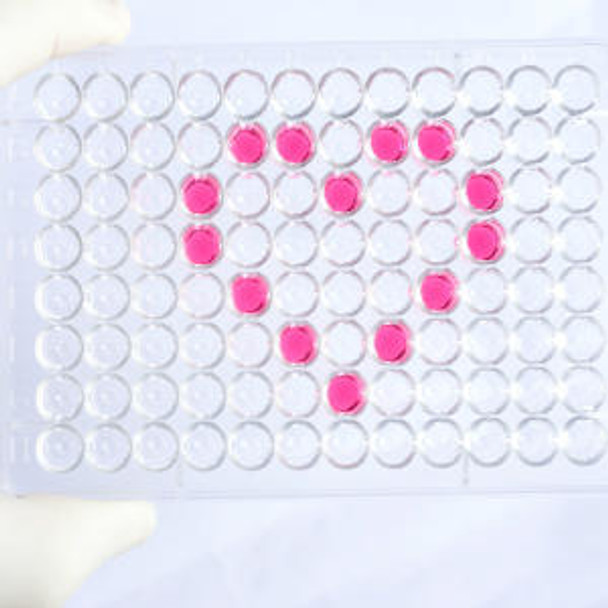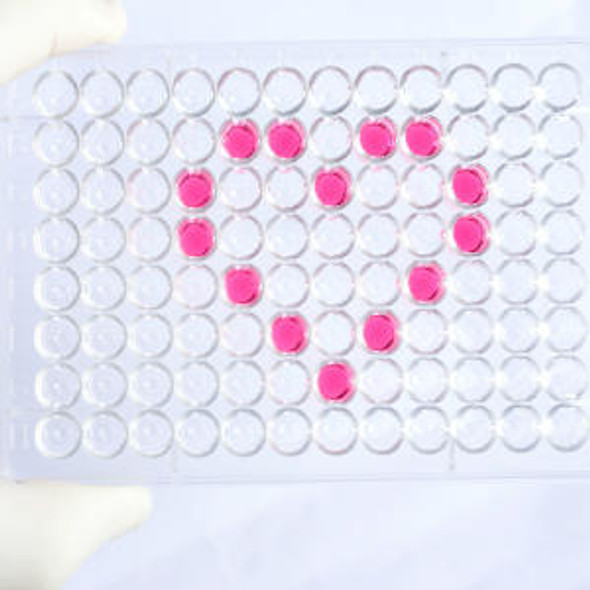Human Zona pellucida sperm-binding protein 3 (ZP3) ELISA Kit
- SKU:
- HUEB1234
- Product Type:
- ELISA Kit
- Size:
- 96 Assays
- Uniprot:
- P21754
- Range:
- 0.625-40 ng/mL
- ELISA Type:
- Sandwich
- Synonyms:
- ZP3, Zona pellucida sperm-binding protein 3, ZP3A, ZP3B, ZPC, Zp-3, Zona pellucida protein C, Zona pellucida glycoprotein 3, Sperm receptor, ZP3A, ZP3B,
- Reactivity:
- Human
Description
| Product Name: | Human Zona pellucida sperm-binding protein 3 (ZP3) ELISA Kit |
| Product Code: | HUEB1234 |
| Alias: | Zona pellucida sperm-binding protein 3, Sperm receptor, ZP3A/ZP3B, Zona pellucida glycoprotein 3, Zp-3, Zona pellucida protein C, ZP3, ZP3A, ZP3B, ZPC |
| Uniprot: | P21754 |
| Reactivity: | Human |
| Range: | 0.625-40 ng/mL |
| Detection Method: | Sandwich |
| Size: | 96 Assay |
| Storage: | Please see kit components below for exact storage details |
| Note: | For research use only |
| UniProt Protein Function: | ZP3: The mammalian zona pellucida, which mediates species- specific sperm binding, induction of the acrosome reaction and prevents post-fertilization polyspermy, is composed of three to four glycoproteins, ZP1, ZP2, ZP3, and ZP4. ZP3 is essential for sperm binding and zona matrix formation. Belongs to the ZP domain family. ZPC subfamily. 3 isoforms of the human protein are produced by alternative splicing. |
| UniProt Protein Details: | Protein type:Membrane protein, integral; Extracellular matrix Chromosomal Location of Human Ortholog: 7q11.23 Cellular Component: acrosome; cytoplasm; endoplasmic reticulum; extracellular matrix; extracellular region; extracellular space; Golgi apparatus; multivesicular body; perinuclear region of cytoplasm; plasma membrane; secretory granule Molecular Function:acrosin binding; carbohydrate binding; manganese ion transmembrane transporter activity; protein binding; signal transducer activity; store-operated calcium channel activity Biological Process: binding of sperm to zona pellucida; blastocyst formation; humoral immune response mediated by circulating immunoglobulin; intracellular protein transport; manganese ion transport; negative regulation of transcription, DNA-dependent; oocyte development; phosphoinositide-mediated signaling; positive regulation of humoral immune response; positive regulation of inflammatory response; positive regulation of interferon-gamma production; positive regulation of interleukin-4 production; positive regulation of leukocyte migration; positive regulation of phosphatidylinositol biosynthetic process; positive regulation of protein kinase activity; positive regulation of protein kinase B signaling cascade; positive regulation of T cell proliferation; positive regulation of transcription, DNA-dependent; positive regulation of type IV hypersensitivity |
| NCBI Summary: | The zona pellucida is an extracellular matrix that surrounds the oocyte and early embryo. It is composed primarily of three or four glycoproteins with various functions during fertilization and preimplantation development. The protein encoded by this gene is a structural component of the zona pellucida and functions in primary binding and induction of the sperm acrosome reaction. The nascent protein contains a N-terminal signal peptide sequence, a conserved ZP domain, a C-terminal consensus furin cleavage site, and a transmembrane domain. It is hypothesized that furin cleavage results in release of the mature protein from the plasma membrane for subsequent incorporation into the zona pellucida matrix. However, the requirement for furin cleavage in this process remains controversial based on mouse studies. A variation in the last exon of this gene has previously served as the basis for an additional ZP3 locus; however, sequence and literature review reveals that there is only one full-length ZP3 locus in the human genome. Another locus encoding a bipartite transcript designated POMZP3 contains a duplication of the last four exons of ZP3, including the above described variation, and maps closely to this gene. [provided by RefSeq, Jul 2008] |
| UniProt Code: | P21754 |
| NCBI GenInfo Identifier: | 251757420 |
| NCBI Gene ID: | 7784 |
| NCBI Accession: | P21754.2 |
| UniProt Secondary Accession: | P21754,Q06633, Q29RW0, |
| UniProt Related Accession: | P21754 |
| Molecular Weight: | 41,272 Da |
| NCBI Full Name: | Zona pellucida sperm-binding protein 3 |
| NCBI Synonym Full Names: | zona pellucida glycoprotein 3 (sperm receptor) |
| NCBI Official Symbol: | ZP3 |
| NCBI Official Synonym Symbols: | ZPC; ZP3A; ZP3B; Zp-3 |
| NCBI Protein Information: | zona pellucida sperm-binding protein 3 |
| UniProt Protein Name: | Zona pellucida sperm-binding protein 3 |
| UniProt Synonym Protein Names: | Sperm receptor; ZP3A/ZP3B; Zona pellucida glycoprotein 3; Zp-3 |
| Protein Family: | Zona pellucida sperm-binding protein |
| UniProt Gene Name: | ZP3 |
| UniProt Entry Name: | ZP3_HUMAN |
| Component | Quantity (96 Assays) | Storage |
| ELISA Microplate (Dismountable) | 8×12 strips | -20°C |
| Lyophilized Standard | 2 | -20°C |
| Sample Diluent | 20ml | -20°C |
| Assay Diluent A | 10mL | -20°C |
| Assay Diluent B | 10mL | -20°C |
| Detection Reagent A | 120µL | -20°C |
| Detection Reagent B | 120µL | -20°C |
| Wash Buffer | 30mL | 4°C |
| Substrate | 10mL | 4°C |
| Stop Solution | 10mL | 4°C |
| Plate Sealer | 5 | - |
Other materials and equipment required:
- Microplate reader with 450 nm wavelength filter
- Multichannel Pipette, Pipette, microcentrifuge tubes and disposable pipette tips
- Incubator
- Deionized or distilled water
- Absorbent paper
- Buffer resevoir
*Note: The below protocol is a sample protocol. Protocols are specific to each batch/lot. For the correct instructions please follow the protocol included in your kit.
Allow all reagents to reach room temperature (Please do not dissolve the reagents at 37°C directly). All the reagents should be mixed thoroughly by gently swirling before pipetting. Avoid foaming. Keep appropriate numbers of strips for 1 experiment and remove extra strips from microtiter plate. Removed strips should be resealed and stored at -20°C until the kits expiry date. Prepare all reagents, working standards and samples as directed in the previous sections. Please predict the concentration before assaying. If values for these are not within the range of the standard curve, users must determine the optimal sample dilutions for their experiments. We recommend running all samples in duplicate.
| Step | |
| 1. | Add Sample: Add 100µL of Standard, Blank, or Sample per well. The blank well is added with Sample diluent. Solutions are added to the bottom of micro ELISA plate well, avoid inside wall touching and foaming as possible. Mix it gently. Cover the plate with sealer we provided. Incubate for 120 minutes at 37°C. |
| 2. | Remove the liquid from each well, don't wash. Add 100µL of Detection Reagent A working solution to each well. Cover with the Plate sealer. Gently tap the plate to ensure thorough mixing. Incubate for 1 hour at 37°C. Note: if Detection Reagent A appears cloudy warm to room temperature until solution is uniform. |
| 3. | Aspirate each well and wash, repeating the process three times. Wash by filling each well with Wash Buffer (approximately 400µL) (a squirt bottle, multi-channel pipette,manifold dispenser or automated washer are needed). Complete removal of liquid at each step is essential. After the last wash, completely remove remaining Wash Buffer by aspirating or decanting. Invert the plate and pat it against thick clean absorbent paper. |
| 4. | Add 100µL of Detection Reagent B working solution to each well. Cover with the Plate sealer. Incubate for 60 minutes at 37°C. |
| 5. | Repeat the wash process for five times as conducted in step 3. |
| 6. | Add 90µL of Substrate Solution to each well. Cover with a new Plate sealer and incubate for 10-20 minutes at 37°C. Protect the plate from light. The reaction time can be shortened or extended according to the actual color change, but this should not exceed more than 30 minutes. When apparent gradient appears in standard wells, user should terminatethe reaction. |
| 7. | Add 50µL of Stop Solution to each well. If color change does not appear uniform, gently tap the plate to ensure thorough mixing. |
| 8. | Determine the optical density (OD value) of each well at once, using a micro-plate reader set to 450 nm. User should open the micro-plate reader in advance, preheat the instrument, and set the testing parameters. |
| 9. | After experiment, store all reagents according to the specified storage temperature respectively until their expiry. |
When carrying out an ELISA assay it is important to prepare your samples in order to achieve the best possible results. Below we have a list of procedures for the preparation of samples for different sample types.
| Sample Type | Protocol |
| Serum | If using serum separator tubes, allow samples to clot for 30 minutes at room temperature. Centrifuge for 10 minutes at 1,000x g. Collect the serum fraction and assay promptly or aliquot and store the samples at -80°C. Avoid multiple freeze-thaw cycles. If serum separator tubes are not being used, allow samples to clot overnight at 2-8°C. Centrifuge for 10 minutes at 1,000x g. Remove serum and assay promptly or aliquot and store the samples at -80°C. Avoid multiple freeze-thaw cycles. |
| Plasma | Collect plasma using EDTA or heparin as an anticoagulant. Centrifuge samples at 4°C for 15 mins at 1000 × g within 30 mins of collection. Collect the plasma fraction and assay promptly or aliquot and store the samples at -80°C. Avoid multiple freeze-thaw cycles. Note: Over haemolysed samples are not suitable for use with this kit. |
| Urine & Cerebrospinal Fluid | Collect the urine (mid-stream) in a sterile container, centrifuge for 20 mins at 2000-3000 rpm. Remove supernatant and assay immediately. If any precipitation is detected, repeat the centrifugation step. A similar protocol can be used for cerebrospinal fluid. |
| Cell culture supernatant | Collect the cell culture media by pipette, followed by centrifugation at 4°C for 20 mins at 1500 rpm. Collect the clear supernatant and assay immediately. |
| Cell lysates | Solubilize cells in lysis buffer and allow to sit on ice for 30 minutes. Centrifuge tubes at 14,000 x g for 5 minutes to remove insoluble material. Aliquot the supernatant into a new tube and discard the remaining whole cell extract. Quantify total protein concentration using a total protein assay. Assay immediately or aliquot and store at ≤ -20 °C. |
| Tissue homogenates | The preparation of tissue homogenates will vary depending upon tissue type. Rinse tissue with 1X PBS to remove excess blood & homogenize in 20ml of 1X PBS (including protease inhibitors) and store overnight at ≤ -20°C. Two freeze-thaw cycles are required to break the cell membranes. To further disrupt the cell membranes you can sonicate the samples. Centrifuge homogenates for 5 mins at 5000xg. Remove the supernatant and assay immediately or aliquot and store at -20°C or -80°C. |
| Tissue lysates | Rinse tissue with PBS, cut into 1-2 mm pieces, and homogenize with a tissue homogenizer in PBS. Add an equal volume of RIPA buffer containing protease inhibitors and lyse tissues at room temperature for 30 minutes with gentle agitation. Centrifuge to remove debris. Quantify total protein concentration using a total protein assay. Assay immediately or aliquot and store at ≤ -20 °C. |
| Breast Milk | Collect milk samples and centrifuge at 10,000 x g for 60 min at 4°C. Aliquot the supernatant and assay. For long term use, store samples at -80°C. Minimize freeze/thaw cycles. |









